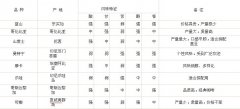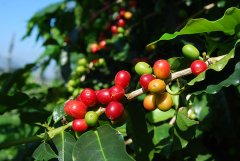The fragrance of coffee beans is smooth and attractive.
The Arabs of ancient times first dried and boiled coffee beans and drank the juice as a stomach medicine, thinking it would help digestion. Later, coffee was found to have a refreshing effect, and because Muslims were forbidden to drink alcohol, coffee was used instead of alcoholic beverages as a refreshing drink and often drunk. Although coffee was discovered in the Middle East, the coffee tree originated in a region of Africa called Kaffa, which is now Ethiopia. From here, coffee spread to Yemen, Arabia and Egypt. It was in Egypt that coffee developed rapidly and quickly became popular in people's daily life. By the 16th century, early merchants were selling coffee in Europe, introducing coffee as a new drink into Western customs and life.
East Africa is one of the three most important coffee producing countries in the world. Among the more outstanding are "Top East African Ethiopian Highland Coffee Beans" and "Kenya Coffee Beans". Below, we will take you to visit several major coffee beans producing countries, for you to uncover those hidden behind the interesting story of coffee beans.
In order to get a cup of smooth coffee, you must first understand the coffee beans.
1. Jamaica
Mention Jamaica and we immediately hear Blue Mountain coffee. The rare and expensive true Blue Mountain bean originated from Wallensford Coffee Garden, but now it has been extended to the Blue Mountain Mountains at an altitude of more than 1,000 meters. As long as the tree species and processing procedures of the estate meet certain standards, the government will issue a certificate authorizing the use of the name "Blue Mountain". It used to be the protagonist of coffee myths, but unfortunately many people think that the legendary characteristics-rich aroma, complete texture, and even taste of the perfect combination of sour-are no longer, fifteen years ago there is a good sour, now can only be found in memories. In spite of this, its price is still rising. In Taiwan, the retail price of raw beans with guarantee is usually more than 2000 yuan per kilogram. In the raw bean market where sacks are widely used, Blue Mountain beans that insist on drum packaging are particularly valuable. "Jamaica High Mountain" refers to coffee beans grown in other hills below a kilometer on the island, which are of a more ordinary quality and have a mild texture and acidity. As for Blue Mountain Blend or Blue Mountain Style, it's usually a blend based on good Colombia beans, intended to mimic the taste of Blue Mountain. There's no absolute connection to Jamaica, and you won't find any real Blue Mountain beans in Blue Mountain Style.
2. Dominican Republic
Beans grown in the Dominican Republic are often called Santo Domingan (their old name), and coffee plantations there are mainly around the mountains in the center of the island. There are four kinds of washed alpine coffee on the market: Cibao, Bani, Ocoa, Barahona, and the latter three are especially praised. The soft ripe fruit sweetness of Barahona is similar to that of Haiti coffee; Barahona has a higher acidity and a thick texture typical of Caribbean beans, closer to that of Jamaica mountains in quality and character. Bake to medium depth to highlight their sweetness.
3. Puerto Rico
The bean named Yauco Selecto is the best example of Caribbean beans, rich in texture, balanced in taste, soft but complex with depth. Deep-roasted Caribbean beans, without the harsh, burnt taste common to other deep-roasted beans, are suitable for Plunger or French Press and other long-soaking cooking methods.
4. Yemen
The word mocha has many meanings. Around 600 AD, the first coffee beans far away from their hometown-Ethiopia-took root in Yemen on the other side of the Red Sea, and since then the coffee industry has been launched all over the world. Since the most important port of export for Yemeni coffee in the early days was Mocha Port (now silted), Yemeni coffee was also called "mocha" beans; over time, some people began to use "mocha" as a nickname for coffee, similar to the current situation of "Java." Later, because mocha coffee has a chocolate-like aftertaste, the term "mocha" was extended to a mixed drink of hot chocolate and coffee. Therefore, the same is "mocha", mocha beans, mocha pot and mocha coffee in Italian coffee, representing three meanings. Yemen mocha today is no different from its ancestors more than 1,000 years ago, and it is still the highest level of traditional hand-dried beans-although it varies in size and has a lot of impurities in raw beans. The two most commonly seen origins are Matari and Sanani; Matari beans have more texture, chocolate and acidity, while Sanani beans are more balanced and fragrant. Generally speaking, mocha beans are small in average size, with a wild spicy flavor of ginger, bright and distinctive taste, pleasant fruit acidity, and rich wine-like texture. No wonder they are known as Bordeaux wines in coffee. In mixed coffee, mocha usually plays the role of treble, responsible for stimulating flavor.
5. Ethiopia
The Ethiopian plateau is the birthplace of coffee. In the eastern part, near Harrar, the ancient capital, mocha beans (Harrar,Harari,Harer or Harar) are still produced by traditional drying methods at an altitude of about 2,000 meters above sea level. Halal's texture is medium, with a fruity, wine-like flavor, good Halal's wildness is comparable to the best Yemeni mocha. Dried beans from other regions, such as Gimbi or Ghimbi, Jima,Jimma or Djimah, and Sidamo, are equally wild and wine-like, but less rich and coarse in texture. Washed mocha from West Kimby has the same acid as Harrah's, but packaged with a richer, more balanced feel and heavier texture. For washed beans from the south, such as Sidamo and Gemma, less wine acid is preserved and more tender lemon and flower flavors are substituted. The best of the best is produced in a small, higher area of sidamo called Yirgacheffe, which has a rich taste that brushes through the taste buds and leaves an endless aftertaste. The slightly sour taste is similar to Sumatra and moves downstream from the rich texture. In addition, it adds a unique soft floral fragrance, which is truly the only coffee in the world.
6. Kenya
Kenya's coffee is grown near the Kenyan mountains in the middle and is sometimes named after the capital Nairobi to ensure its quality. Here beans are graded according to size, the largest is AA, then A and B, etc., and have nothing to do with the origin, so the same AA beans, quality and characteristics may vary greatly. Except for Yemen and Ethiopia's dry mocha, most coffee on the continent is washed. With state support, Kenya's washed arabica beans are of high average quality and are handled with considerable care. Good Kenyan beans not only have the same strong acid as mocha, stimulate the sides of the tongue, it even has mocha lack of rich texture, in African coffee, it can brew a balanced drink.
7. United Republic of Tanzania
Most Tanzanian beans are grown in Mr. Kilimanjaro and Mt. Meru near the northern Kenyan border. The Meru area is commonly referred to as "Krimanjaro" and is occasionally named after Moshi or Arusha. On the south side of the border, a little washed arabica beans are also produced, named after the nearby city of Mbeya or the distribution center of Pare. The classification is similar to Kenya, with English letters distinguishing sizes. Most Tanzanian beans have typical African bean characteristics. The better crimenjaro is similar to regular Kenya, has a thick texture, is usually milder in acidity than Kenya, and evenly stimulates the middle and lateral taste buds at the back of the tongue. It tastes a bit like a tomato or soda. As for the southern beans, they are comparable to the second-grade washed mocha, with a soft and pleasing weak acid, a round taste, and a medium texture. Beans from neighbouring Malawi also have qualities similar to those of Tanzanian beans.
8. Uganda
In the east, on the western slopes of Mr. Elgon, near the Kenyan border, a fairly good Arabica bean, called Bugisu or Bugishu, is produced, with a flavor similar to Kenya, but with a thinner texture.
9. Zimbabwe
Zimbabwe is also a typical East African bean. Good Zimbabwe has a medium texture, but its strong acidity and fruit wine tone can be compared with Kenya, and it also has a hint of black pepper. The finest Zimbabwe beans are grown in the eastern region near Mozambique and are graded according to size, with 053 being the highest.
10. Costa Rica
Costa Rica's high latitudes produce coffee beans that are famous in the world for their rich, mild taste, but extremely sour, and the beans are carefully processed to produce high quality coffee. The famous coffee is produced in the Central Plateau, where the soil consists of successive layers of volcanic ash and dust.
Global coffee prices continue to rise as major buyers seek higher quality coffee, while coffee producers Uganda, Rwanda and Ethiopia are in the midst of harvest season, Kenya's Standard newspaper reported. East African countries are at higher altitudes and coffee plantations are usually small-scale operations, and African growers are better able to care for coffee trees than large-scale plantations like Brazil, industry sources say.
Important Notice :
前街咖啡 FrontStreet Coffee has moved to new addredd:
FrontStreet Coffee Address: 315,Donghua East Road,GuangZhou
Tel:020 38364473
- Prev

The flavor of coffee from the place of origin
After coffee beans spread to all parts of the world, due to the different climate, soil quality, planting methods and processing methods, the taste of coffee beans can be said to be completely different. Here is a list of the basic flavor characteristics of Arabica coffee beans from different producing areas (it should be noted that the flavor of coffee produced by different producing areas and different farms in the same place will be different. Some coffee products are generally believed to be
- Next

Three original species of Coffee Tree
Everyone should have heard of Elaraby as a kind of coffee. The best quality beans of the famous Colombian coffee are all Elaraby varieties. When it comes to the variety of coffee, we must first understand the type of coffee tree. At present, the most important coffee beans in the world are mainly from Arabica, Robata and Liberia. these three varieties of coffee beans are the three original species of coffee trees.
Related
- Guji coffee producing area of Guji, Ethiopia: Humbela, Shakiso, Wulaga
- What is the most expensive variety of Qiloso in BOP multi-variety group?
- How to store the coffee beans bought home?
- Why are Yemeni coffee beans so rare now?
- Ethiopian Sidamo all Red Fruit Sun Sun Santa Vini Coffee beans
- SOE is mostly sour? What does it mean? Is it a single bean? what's the difference between it and Italian blending?
- Is Italian coffee beans suitable for making hand-brewed coffee?
- How to choose coffee beans when making cold coffee? What kind of coffee beans are suitable for making cold coffee?
- Just entered the pit to make coffee, what kind of coffee beans should be chosen?
- Can only Japan buy real Blue Mountain Coffee? What are authentic Jamaican Blue Mountain coffee beans?

